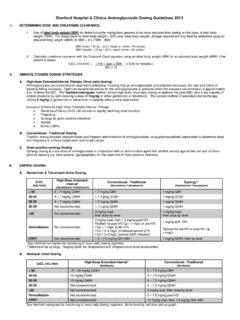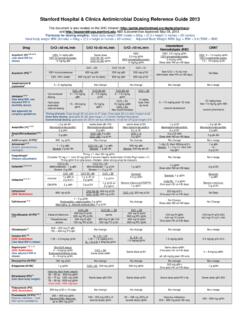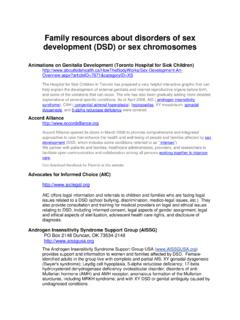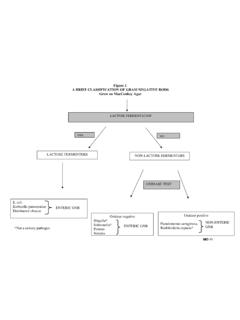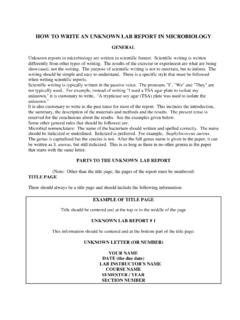Transcription of Pediatric Urinary Tract Infections - Stanford Medicine
1 Pediatric Urinary Tract InfectionsSteven L. Chang, MD, Linda D. Shortliffe, MDTD epartment of Urology, Stanford University School of Medicine , 300 Pasteur Drive, S-287, Stanford , CA 94305-2200, USAThe Urinary Tract is a common site of infection in the Pediatric the generally benign course of Urinary Tract infection (UTI) in the adultpopulation, UTI in the Pediatric population is well recognized as a cause of acutemorbidity and chronic medical conditions, such as hypertension and renal insuf-ficiency in adulthood. As a result, it is crucial to have a clear understanding ofthe pathogenesis of UTI, risk factors, indications for diagnostic tests, and theappropriate uses of antimicrobial agents in the management of children with UTI is defined as colonization of a pathogen occurring anywhere along theurinary Tract : kidney, ureter, bladder, and urethra.
2 Traditionally, UTIs have beenclassified by the site of infection (ie, pyelonephritis [kidney], cystitis [bladder],urethra [urethritis]) and by severity (ie, complicated versus uncomplicated). Acomplicated UTI describes Infections in Urinary tracts with structural or func-tional abnormalities or the presence of foreign objects, such as an indwellingurethral catheter. This model does not necessarily reflect clinical management,however. In children, a simpler and more practical approach is to categorize UTIas a first infection versus recurrent infection. Recurrent Infections can be fur-ther subdivided into (1) unresolved bacteriuria, (2) bacterial persistence, and(3) reinfection (Fig. 1).The initial UTI documented by a proper urine culture is the first of the Urinary Tract generally resolve with adequate treatment in most0031-3955/06/$ see front matterD2006 Elsevier Inc.
3 All rights Shortliffe).Pediatr Clin N Am 53 (2006) 379 400children. In neonates and infants, however, they are presumed to be complicatedbecause of the high association between Urinary Tract malformation and con-current bacteremia, which predispose children to acute morbidity and long-termrenal insufficiency[1,2].The recurrence of a UTI may be caused by several reasons. Unresolved bac-teriuria is most commonly caused by inadequate antimicrobial therapy. Sub-therapeutic levels of the antimicrobial agents may be a result of noncompliance,malabsorption, suboptimal drug metabolism, and resistant uropathogens unre-sponsive to attempted therapy[3]. In these cases, infection typically resolvesafter altering the therapy according to antimicrobial sensitivities determined by aproper urine persistence and reinfection occur after sterilization of the urine hasbeen documented.
4 In the case of bacterial persistence, the nidus of infection inthe Urinary Tract is not eradicated. Characteristically, the same pathogen is docu-mented on urine cultures during subsequent episodes of UTI despite negativecultures after treatment. The uropathogen frequently resides in a location that isshielded from antimicrobial therapy. These protected sites are often anatomicabnormalities, including infected Urinary calculi[4], necrotic papillus[5],orforeign objects, such as an indwelling ureteral stent[6,7]or urethral catheters[8], which once infected may not be sterilized. Identification of the anatomicabnormality is essential because surgical intervention (extirpation) may be nec-essary to eradicate the source of infection (Box 1).
5 In contrast to bacterial persistence, reinfection is characterized by differentpathogens documented on proper urine cultures with each new UTI. UTI mostcommonly occurs by periurethral colonization[9]and by the fecal-perineal-urethral route[10]. Rarely, a fistula between the Urinary Tract and gastrointestinaltract serves as the source of reinfection[11]. It is important to note thatEscherichia colioccurs in many different serotypes, and documentation of whatseems to be recurrentE coliUTI may, in fact, represent reinfection rather thanbacterial persistence[12]. Serotyping (or careful examination of antimicrobialFig. 1. Functional classification of profile) ultimately can establish a diagnosis of reinfection in equivocalsituations.
6 As the pathogenesis of UTI has become better understood, it seemsthat some element of bacterial persistence is more common than previouslythought[13]. Similar to bacterial persistence in abnormal conditions with rein-fection such as fistulae, surgery may be necessary to correct the source of infec-tion (Box 1).EpidemiologyThe true incidence of Pediatric UTI is difficult to determine because there arevarying presentations that range from an absence of specific Urinary complaints tofulminant urosepsis. Data from the Urologic Disease in America project,however, suggest that Pediatric UTI constitutes a significant health care burdenon the American public. The study revealed that Infections of the Urinary tractaffect to of children every year and account for more than millionoffice visits annually.
7 Inpatient hospital costs for children with pyelonephritistotal more than $180 million per year in the United States[14].The epidemiology of Pediatric UTI varies based on age and gender (Table 1).During the first year of life, boys have a higher incidence of UTI; in all other agegroups, girls are more prone to developing UTI. During the first year of life, theincidence of UTI in girls is compared with in boys[15]. During thefirst 6 months, uncircumcised boys have a 10- to 12-fold increased risk fordeveloping UTI[9,16]. In children aged 1 to 5 years, the annual incidence ofUTI is to for girls and to for boys[17]. The incidence ofa UTI is largely unchanged from age 6 to 16 years, with an annual incidenceBox 1. Surgically correctable causes of recurrent infectionInfection stonesInfected nonfunctional renal segmentsInfected ureteral stumps after nephrectomyVesicointestinal or urethrorectal fistulaeVesicovaginal fistulaeInfected necrotic papillaeUnilateral medullary sponge kidneyInfected urachal cystInfected urethral diverticulum or periurethral glandsData fromShortliffe LD.
8 Urinary Tract infection in infants andchildren. In: Walsh P, Retik AB, Vaughn Ed, et al, editors. Camp-bell s urology. 8thedition. Philadelphia: WB Saunders; 1846 Urinary Tract infections381of to for girls and to for boys[18]. During earlyadulthood (18 24 years), the annual incidence of UTI in men remains relativelylow at [19]; however, it increases substantially in women to [20].UropathogensAlthough UTI may be caused by any pathogen that colonizes the Urinary Tract (eg, fungi, parasites, and viruses), most causative agents are bacteria of entericorigin (Box 2). The causative agent varies based on age and coliis the most frequent documented uropathogen. Amongneonates, UTI secondary to group B streptococci is more common than in olderpopulations[21].
9 In immunocompromised children and children with indwellingcatheters,Candidamay be isolated from the urine[22]. Nosocomial infectionsare typically more difficult to treat and are caused by various organisms,includingE. coli,Candida,Enterococcus,Enterobacter, andPseudomonas[23].PathogenesisBacterial clonal studies strongly support entry into the Urinary Tract by thefecal-perineal-urethral route with subsequent retrograde ascent into the bladder[10]. Because of differences in anatomy, girls are at a higher risk of UTI thanboys beyond the first year of life. In girls, the moist periurethral and vaginal areaspromote the growth of uropathogens. The shorter urethral length increases thechance for ascending infection into the Urinary Tract .
10 Once the uropathogenreaches the bladder, it may ascend to the ureters and then to the kidneys by someas-yet undefined mechanism. Additional pathways of infection include nosoco-mial infection through instrumentation, hematogenous seeding in the setting ofsystemic infection or a compromised immune system, and direct extensioncaused by the presence of fistulae from the bowel or Urinary Tract (ie, kidney, ureter, bladder, and urethra) is a closed, normallysterile space lined with mucosa composed of epithelium known as transitionalcells. The main defense mechanism against UTI is constant antegrade flow ofurine from the kidneys to the bladder with intermittent complete emptying of thebladder via the urethra. This washout effect of the Urinary flow usually clears theTable 1 Incidence of Pediatric Urinary Tract infection by age group and genderAge (y)Female (%)Male (%) Tract of pathogens[24].

